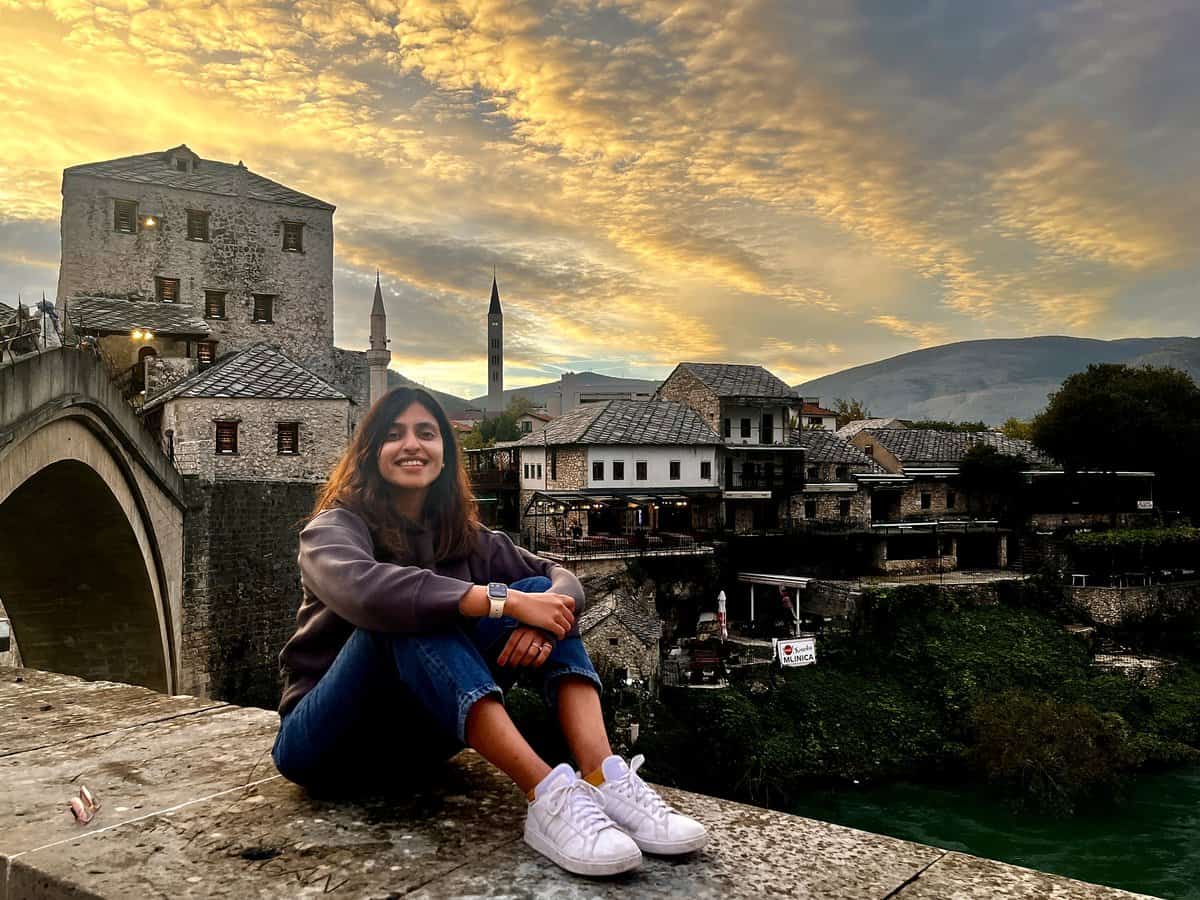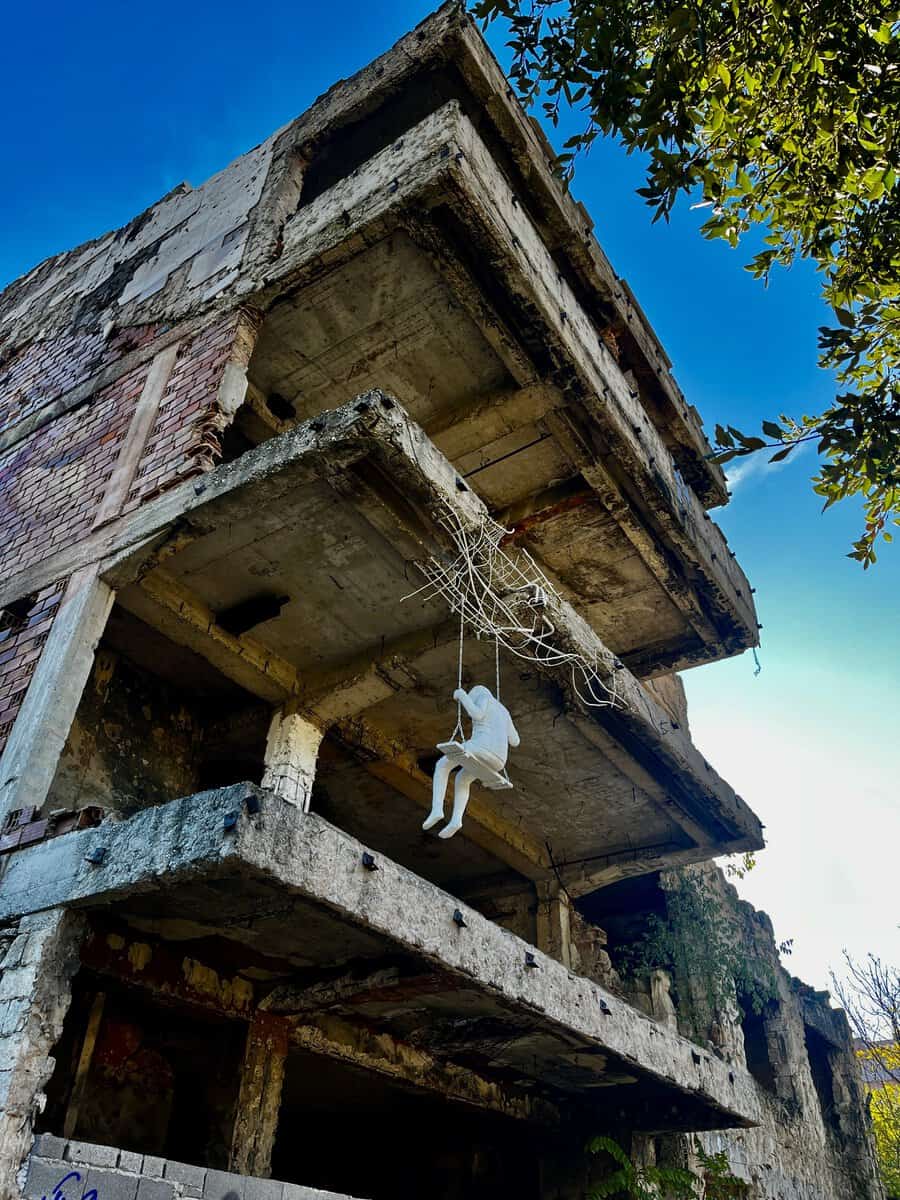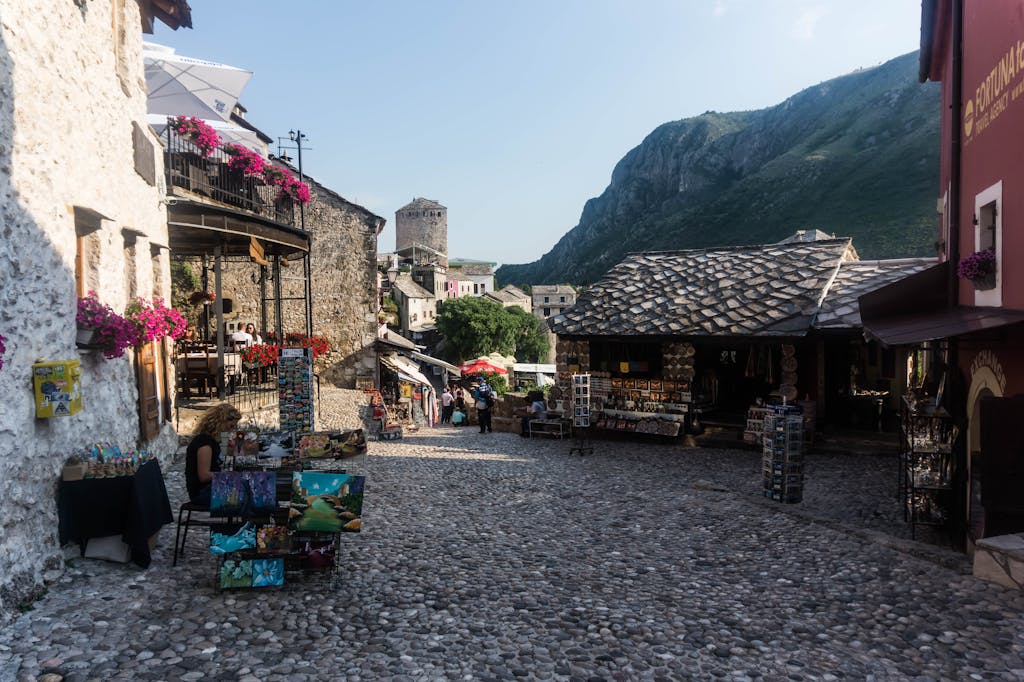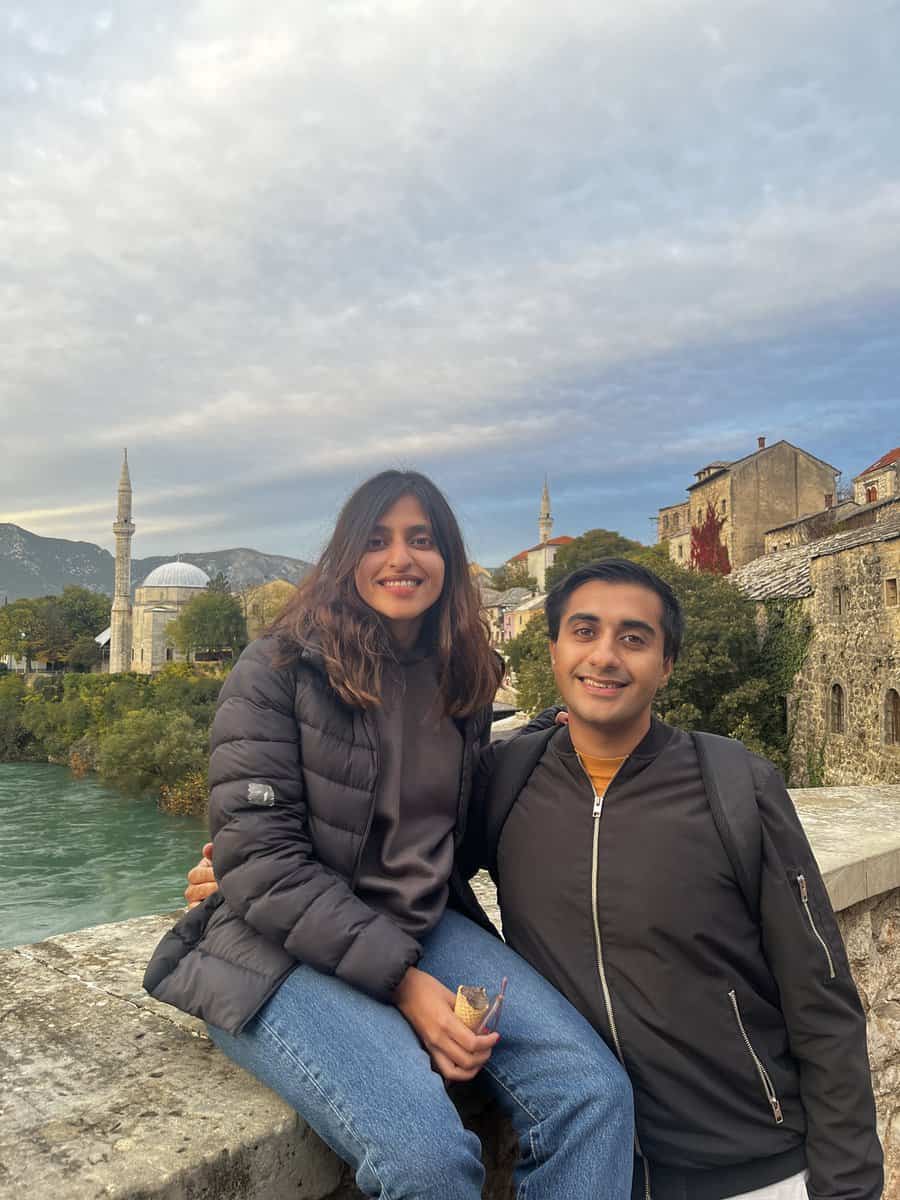Mostar is not a city you breeze through.
I arrived by train from Sarajevo on a cold morning in November, expecting beauty – Ottoman bridges, minarets, riverside cafes – and found all of that. But also: bullet holes. Gravestones. A skyline still learning to heal.
Mostar isn’t subtle. Its history doesn’t sit quietly in museums. It climbs up sniper towers, spills into street art, and echoes in the silence between mosques calling to prayer. I spent a week here with my partner, longer than most travelers do, and I’m glad we did. The crowds that flood the bazaar at midday rarely stay for the evening, and it’s in those off-hours that the city breathes differently. Softer. Truer.
I visited during a time when another war had just erupted in Gaza, and that shaped how I saw everything. The Museum of War and Genocide in Mostar hit harder. The memories of 1993 felt more urgent. It made me think about how quickly the world forgets, how easily we scroll past devastation, how conflict becomes background noise unless it’s our own.
If you’re planning to visit Mostar, stay longer than a day. Let it get under your skin. Let it bother you. Let it remind you that travel isn’t always about escape.
A Brief History of Mostar
Mostar has been shaped by layers of history. The Ottomans built much of what people now come to see – mosques, bridges, old stone alleys. Later came the Austro-Hungarians, and with them, another shift in architecture, language, and power. For a long time, different religions, languages, and identities lived side by side.
That changed in the 1990s. When Bosnia declared independence, war broke out. Between 1992 and 1995, Mostar saw some of the worst of the conflict. Entire neighborhoods were shelled. People fled, or didn’t make it out. The city became one of the war’s most divided.
Today, the fighting is over, but its traces remain – in buildings that were never rebuilt, in the quiet divide between east and west. The Neretva River still acts as an informal boundary: the east side is mostly Bosniak, the west mostly Croat. You’ll feel that if you spend time walking across both sides. The conversations can still feel complicated.
What to Do in Mostar
1. Walk Across Stari Most Before the Crowds Arrive
Mostar’s Old Bridge is easily its most photographed spot, and with good reason. The single stone arch curves high above the Neretva River, framed by medieval towers on either side. It’s beautiful. But it’s also better when it’s quiet.
We went early in the morning, before the day-trippers arrived. The bridge was wet from rain, the stone a little slippery underfoot. There were no crowds, no phones in the air, just the sound of the river below.
Stari Most was originally built in the 1500s during Ottoman rule. It stood for over 400 years before being destroyed during the war in 1993. The version that stands today is a reconstruction, opened in 2004, using traditional techniques. It looks old, but it’s not. And that tension – between history and memory – is part of what makes it so powerful.
In warmer months, you might see locals diving off the bridge. It’s a long-standing tradition, though not exactly a casual one. There’s usually a bit of a show before the jump – collecting tips from onlookers, hyping the moment. We didn’t see any of that (too cold in November), but even without it, the bridge held its own.
Time Needed: ~15–20 minutes (more if you linger or grab a coffee nearby)
Location: Stari Most, Old Town
Tip: Best experienced early morning or just after sunset
2. Explore the Old Town
Mostar’s Old Town is small enough to walk in an afternoon, but don’t rush it. The main cobblestone street, Kujundžiluk, winds its way through a stretch of copper shops, souvenir stalls, and stone buildings that look like they haven’t changed in centuries.
Yes, it’s touristy. You’ll find the usual fridge magnets and postcards. But there’s also craftsmanship here – metalworkers tapping designs into coffee sets, rugs hanging from balconies, old men selling books and war memorabilia that may or may not be real.
I had ice cream from a small cart tucked between two souvenir shops, sat on a bench and watched the street fill slowly. Later, I stopped at a café for Bosnian coffee, served in a traditional copper džezva, with a sugar cube on the side. You don’t need a long to-do list here. Just wander, stop often, and take your time.
As someone raised Muslim, it was also strange in a way, but kind of comforting, to hear the call to prayer echo through the streets. Mostar is one of the few places in Europe I’ve heard that.
Time Needed: ~1–2 hours (more if shopping or stopping for coffee/food)
Location: Kujundžiluk Street and surrounding alleys
Tip: Visit before noon to avoid heavy foot traffic
3. Koski Mehmed-Pasha Mosque for a View
You’ll spot the minaret before you see the mosque. Koski Mehmed-Pasha is just a short walk from the Old Bridge, and while it’s small, it offers one of the best views in the city.
For a small fee, you can climb the narrow spiral staircase up the minaret. It’s a tight squeeze, with just enough room for one person at a time, but the view from the top is worth it. You get a clean line over the bridge, the river, and the rooftops – a good way to get your bearings if you’ve just arrived.
The mosque itself is modest. Inside, it’s quiet and cool, with stained glass windows and worn carpets. You don’t need long here. It’s the kind of stop that works well between wandering the bazaar and finding your next coffee break.
Time Needed: ~30–45 minutes
Cost: €4 (~$5 USD) for mosque entry only, or €7 (~$7.50 USD) for a combined ticket that includes climbing the minaret.
Location: Just northeast of Stari Most
Opening Hours: Typically 9am–8:30pm (seasonal variation)

4. Museum of War and Genocide Victims
I’m not usually one for museums, but this one stopped me cold.
The Museum of War and Genocide Victims is small, tucked inside a modest building in the center of town. Inside, it’s quiet. No flashy exhibits. Just personal stories, photos, video interviews, and the belongings of people who lived – and died – through the Bosnian War.
There are rooms filled with uniforms, letters, household items pulled from ruins. Names on the wall. A chair from a concentration camp. A set of keys someone never came back to claim.
What makes it different from other war museums is that it’s run by survivors. The stories feel close. There’s no distance. No tidy conclusions.
When I visited, the war in Gaza had just begun. It was hard not to draw connections – to think about how quickly civilian lives get flattened by politics, and how easy it is for the world to look away.
At the end of the museum, there’s a wall where visitors leave handwritten Post-its. Most are messages of grief, solidarity, or quiet reflection. But the day I went, the wall was filled with calls for peace in Gaza. Different war, different time, but the echoes were impossible to ignore.
Time Needed: ~ 1 hour
Cost: 7 EUR / ~$7.50 USD
Location: Near the Old Town, across from the post office
Opening Hours: 9am–5pm (subject to change)
Tip: Cash only when we visited
5. Climb the Sniper Tower (Yes, Really)
This isn’t an official tourist attraction – and technically, it’s closed to the public. But a guy on Reddit said it was fine to go, so I did what anyone would do: found a gap in the wall, climbed up some bricks, and slipped inside.
The Sniper Tower is an abandoned bank building used by Croat forces during the war. From the top floors, snipers fired across the river into the east side of the city. Today, it stands hollowed out and graffitied, with open stairwells and no railings. It’s not exactly safe. But it’s one of the most confronting places I’ve ever been.
Inside, it’s quiet. You move slowly. Bullet holes in the walls. Spray-painted names, slogans, poems. A staircase crumbling in the corner. From the rooftop, you get a panoramic view of Mostar – beautiful, but unsettling when you remember what this place was used for.
I went alone, and I’m glad I did. There’s no curated narrative here. No signs explaining what you’re supposed to feel. You’re left to take it in as it is: raw, unsanitized, and still standing.
Time Needed: ~30–45 minutes
Cost: Free (unofficial site)
Location: Former Ljubljanska Bank building, west side of the river
How to Get There: Enter through a side gap in the wall near the front – not officially marked
Caution: Climb at your own risk; no safety barriers or formal access.
6. Cross the Crooked Bridge
Just a few minutes’ walk from Stari Most is its smaller, quieter cousin — Kriva Ćuprija, or the Crooked Bridge. Built in the 16th century, it arches over a narrow stream like a practice run for its more famous sibling.
Most people pass it quickly on their way to lunch. We paused. There was a small café right by the water, and we ended up sitting there longer than planned. No agenda. No photos to take. Just the sound of the water and the occasional clatter from the kitchen behind us.
Time Needed: ~15–30 minutes
Cost: Free
Location: Just west of the Old Town, near the Hotel-Restaurant Kriva Ćuprija


7. Don’t Forget ‘93
There’s one popular ‘Don’t Forget 93’ mural painted on the riverbank just below Stari Most. You can walk down to it, sit by the water, and take it in. It’s become a sort of photo spot.
Because it’s not just one mural. Once you start looking, you’ll see 1993 everywhere.
Some buildings are still pockmarked with bullet holes. Others have been repaired but carry faded slogans or graffiti – names, dates, accusations. We noticed small plaques set into the walls of houses, sometimes with civilian names, sometimes without explanation at all.
Some parts of the city feel like they’ve chosen to keep quiet. Others are more direct. You don’t need a museum to learn about Mostar’s past. You just need to pay attention.
Time Needed: Ongoing — you’ll notice these throughout the city
Cost: Free
Location: Riverbank below Stari Most (popular spot), plus scattered around west side neighborhoods and near the Sniper Tower
8. Visit the Peace Bell Monument
The Peace Bell doesn’t draw crowds. It’s tucked into a small park on the west side of town, near a Franciscan church with a modern bell tower that looks more like a control tower than a steeple.
The monument was built after the war – part symbol, part attempt. It’s clean and modern, with a bell suspended above a tiled platform. You won’t find much signage or context, just the word “peace” in several languages. You’re left to fill in the rest.
Time Needed: ~10–15 minutes
Cost: Free
Location: Near the Church of St. Peter and Paul, west side of Mostar
9. Admire the Street Art With Eyes Wide Open
You’ll see stencils of doves and soldiers, spray-painted slogans in Bosnian and English, faces of missing people, and tributes to resistance. Some walls are stacked with layers: war, politics, grief, football clubs, more war.
I don’t remember the names of the artists, but a few pieces stuck with me – one near the Sniper Tower with a child in a helmet, another by the railway tracks that just read “Never Forget.” Not subtle, but that’s the point.
You won’t need a map. Just walk – especially through the west side – and keep your eyes up.
Time Needed: ~30–45 minutes, self-guided
Cost: Free
Location: Best found along Braće Fejića, near the Sniper Tower, and west of the river
→ For something deeper, join this Street Art & Graffiti Tour led by a local artist.

10. Walk Along Braće Fejića
Mostar’s east and west sides are split by the Neretva River, but the divide isn’t just geographic. It’s in the buildings, the flags, the street names, and sometimes in the silences.
Walking along Braće Fejića, you start to feel the difference. The street stretches across the city and acts like a seam. On one end, mosques and Ottoman buildings; on the other, Catholic churches, Croatian flags, and a different tone to the graffiti. It’s subtle in parts, obvious in others.
Time Needed: ~30–60 minutes (depending on how far you walk)
Cost: Free
Location: Braće Fejića Street — spans from the east side through to the west
11. Take a Day Trip to Kravice Falls
After a few days in Mostar, Kravice Falls hits differently. Lush, green, and loud with water it’s an easy day trip that gives you space to breathe.
The falls form a semicircle of cascades dropping into a wide pool, surrounded by forest. In summer, you can swim. In colder months, it’s more about the view and the quiet. There’s a boardwalk, a small café, and not much else – which is part of the appeal.
Time Needed: Half day (around 4–5 hours round trip with transport)
Cost: 20 BAM / ~10 EUR / ~$10.50 USD
How to Get There: ~1.5 hour drive from Mostar; buses run in summer or book a guided tour
Tip: Combine with Blagaj or Počitelj if you want a fuller day trip
12. Visit the Dervish Monastery at Blagaj Tekija
Blagaj Tekija looks like something out of a painting — a white Sufi monastery built at the base of a cliff, right where the Buna River bursts out of a cave.
It’s peaceful, low-key, and easy to reach. You can walk along the river, explore the inside of the tekija (shoes off), or just sit at one of the riverside cafés and listen to the water. The whole place feels slower.
Time Needed: 1–2 hours
Cost: 10 BAM / ~5 EUR / ~$5.25 USD
How to Get There: 20–30 minute drive from Mostar; also accessible by taxi or minibus
Tip: Best to go early or late to avoid tour bus groups
13. Wander Počitelj
Počitelj is a fortified village built into the hillside above the Neretva River. It’s small, you can see most of it in under an hour, but worth the trip for the atmosphere alone.
Climb the stone steps to the fortress, peek into the mosque, or just walk through the old alleyways where vines spill over stone walls. It’s the kind of place that feels older than time and doesn’t ask for much from you.
Time Needed: 1–1.5 hours
Cost: Free entry to the town; small fees for specific sites
How to Get There: ~40-minute drive south of Mostar; often included in group day tours
Tip: Wear good shoes — it’s steep and cobbled in parts
→ If you want to visit Počitelj, Kravice Falls, and Blagaj without sorting out transport, this full-day Herzegovina tour from Mostar covers all three, plus a few lesser-known spots like Fortica and Bunski Kanali. A solid option if you’re short on time or prefer to go with a guide.
14. Hike to Fortica Skywalk
Fortica is Mostar’s big viewpoint – a glass-bottomed skywalk perched high above the city. It’s the most “touristy” spot on this list, but the view really is something. On a clear day, you can see across the valley and back toward the hills you’ve just come from.
The skywalk is part of an adventure park, which includes ziplining and rock climbing. But if that’s not your thing, the hike alone is worth it. It’s also one of the best places to reflect on the layout of the city – east, west, river, and all the spaces in between.
Time Needed: 1.5–2 hours (or less if you drive up)
Cost: ~5 BAM / ~2.50 EUR / ~$2.75 USD
How to Get There: ~15-minute drive or ~45-minute uphill hike from Mostar center
Tip: Sunset is popular, bring layers


How Many Days Should You Spend in Mostar?
If you’re just here for the bridge, a day trip is enough. But if you’re here to actually feel the city, stay longer. I’d recommend at least 2 nights – enough time to explore at your own pace, visit key sites, and take a day trip to somewhere like Blagaj Tekija or Kravice Falls.
I stayed a week while working remotely, and while you don’t need that long, I didn’t run out of things to do.
If you’re mapping a longer journey through the Balkans, check out my 10‑Day Itinerary for Montenegro for ideas on what to pair with Mostar.
Where to Stay in Mostar
Mostar is compact and walkable, so don’t stress too much about what “side” you stay on. That said, each area has a slightly different feel:
Old Town (East Side)
If it’s your first time in Mostar or you’re only here for a short visit, this area puts you right next to the Old Bridge and bazaar. It gets crowded during the day but is calm and quiet in the mornings and evenings.
→ Shangri La Mansion: Rooftop terrace with a view and steps from the bridge. Simple, charming, and perfectly located.
→ Hotel-Restaurant Kriva Ćuprija: Set in a beautiful old stone house with a riverside terrace and on-site restaurant.
West Side (Near Rondo / Sniper Tower)
This part of town feels more local and lived-in. It’s a good pick for longer stays or if you’re curious about Mostar’s more political side — street art, post-war monuments, everyday life.
→ Apartments Villa Mike: Quiet, with a garden and mountain views. A great home base if you’re staying a while.
When to Visit Mostar
- Spring (April–June) and Autumn (Sept–Oct): Best balance of good weather and fewer crowds.
- Summer (July–August): Very hot and packed with tour groups.
- Winter (Nov–March): Cold, quiet, atmospheric. I went in November — it was chilly but worth it.
How to Get to Mostar
From Sarajevo
Train: A scenic 2-hour ride through river canyons and mountains. Tickets cost around 14 KM (~€7 / ~$7.50 USD). Trains run twice daily (early morning and late afternoon). The views are worth it, but tickets must often be bought in person and in cash.
→ Check schedule at ZFBH
Bus: More frequent departures and a bit more flexible than the train. The ride takes around 2.5 hours with stops. Tickets cost ~20–25 KM (~€10–13 / ~$11–14 USD). You can book online via Omio or at the station.
→ If you’re visiting Sarajevo as well, I wrote more about Sarajevo in depth here.
From Dubrovnik
Bus: Buses run multiple times daily and take around 3–3.5 hours. While some routes appear to cross the border multiple times, most current buses use the Neum-Stolac route, which involves only one border crossing. Delays at the border are possible, but generally manageable.
→ Tickets via FlixBus
Private Transfer: A good option if you’re short on time or want door-to-door comfort. Prices vary by company, but it’s faster, especially in peak season.
→ Book a private transfer from Dubrovnik to Mostar
Day Tours to Mostar
If you’re not staying overnight, these are the typical options:
- From Sarajevo: Full-day tours with stops at Konjic, Jablanica, Blagaj, Počitelj
→ Full-Day Herzegovina Tour from Sarajevo - From Dubrovnik: Includes Mostar, Kravice Falls, and occasionally Počitelj
→ Dubrovnik to Mostar Day Trip
→ (or fit it into a 2-week Europe itinerary if you’re passing through Bosnia).
Where to Eat in Mostar
You’ll find Bosnian, Turkish, and Mediterranean influences across the city — meat-heavy, but comforting. Most places are affordable, and portions are generous.
- Tima-Irma: Local favorite for grilled meats and big plates of ćevapi
- Hindin Han: Streamside seating and hearty Bosnian dishes
- Restaurant Šadravan: Old Town staple with dolma, sarma, and stews
- Terrace Lagero: Good for dinner with a view of Stari Most
- Pizzeria Napolitano: When you want something non-Bosnian
- Café de Alma: Great spot for Bosnian coffee and people-watching
Mostar doesn’t ask for much – a day, maybe two. But if you give it more, it gives more back.
You’ll see the obvious beauty first: the bridge, the old town, the mountains in the distance. Then you’ll start noticing other things – the gaps in buildings, the names on walls, the way the past still sits quietly in public spaces.
It’s not a city that explains itself. You’ll have to listen for the in-between.
Mostar isn’t stuck in the past, but it hasn’t forgotten it either. That mix – of history and ordinary life, of pain and repair – makes it hard to forget.
